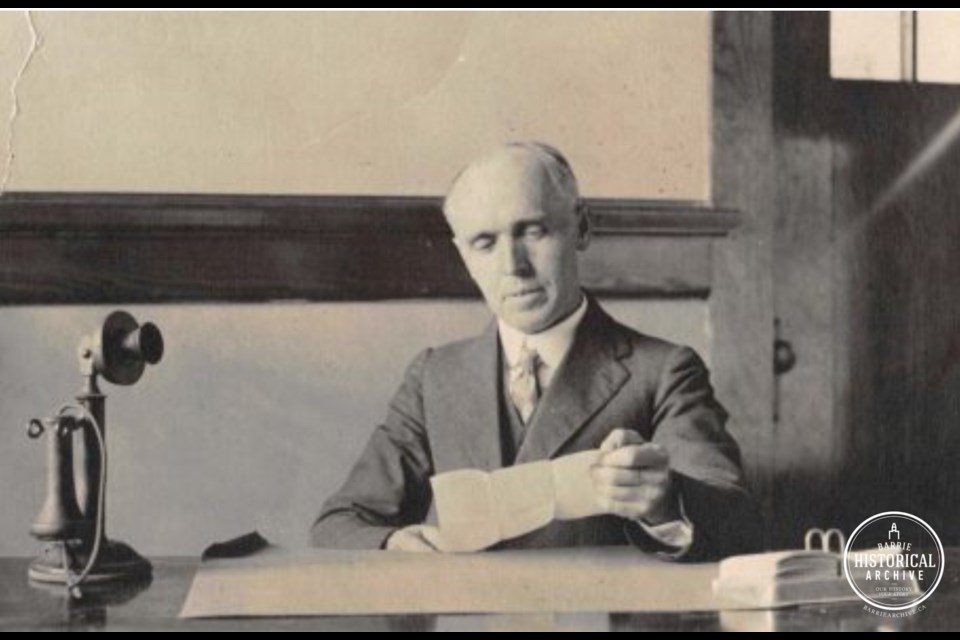“A meeting will be held in the council chamber on Tuesday next at 2 o’clock, to consider the telephone question. Mr. Wardell, of the Bell Telephone Co., will be present to give all particulars respecting telephonic connection between Barrie, Toronto, Hamilton and Newmarket.” — Northern Advance, Dec. 25, 1884
That meeting was a successful event. A year earlier, similar meetings and plans had failed to result in the extension of telephone lines to Barrie, but, this time around, the momentum of the new technology was much stronger than before. Hundreds of poles had been erected and many miles of wire strung.
The Bell Telephone Co. promised to extend its Toronto-to-Newmarket line up to Barrie if the community would gather 20 subscribers for the service. The cost would be $30 a year per subscriber, which included line installation, instrument maintenance and five-minute conversations on the telephone, where possible. As a bonus, a free telephone would be placed in the railway station.
Within weeks, R.A. Douglas, a jewelry store owner located in the Bothwell Block across from the railway station, became the local agent for the Bell Telephone Co.
Until this time, telegraph had been considered the most modern of communication technologies. It had enjoyed this position of dominance for several decades and expected to continue along that path for many more. Of course, the horse and carriage never expected to be replaced by the automobile, either.
Rather ironically, Alexander Graham Bell, who was obsessed with all things related to sound, was tinkering with ways to improve telegraphy when he invented something entirely new.
Western Union, the granddaddy of the telegraph world, sealed the fate of its own product in the end. They had been buying up smaller telegraph companies since at least the 1850s to form their massive company. When Mr. Bell began to compete in the game, they allowed him to run right past them with his newfangled telephonic science. The telephone became the preferred method of quick point-to-point communication, and telegraph was eventually left in the dust.
A year after arriving in Barrie, the Bell Telephone Co. experienced some competition from other would-be providers and so lowered their subscription rate to $25 per annum. After another year had passed, it was apparent that Bell would remain the only telephone service in this town. The rates went back up again.
Slowly, businesses began to get on board. Ads, inviting customers to make telephonic orders, began to appear in the local newspapers. Morgan & McVittie operated a flower shop at the corner of Owen and Wellington Streets. The Northern Advance reported, just before Christmas of 1886, that the shop would soon have a new way of receiving orders.
“A splendid collection or roses and chrysanthemums &c., for Christmas decoration. In order to oblige their numerous customers, they are putting in telephonic communication, which will be in working order by Jan. 1st.”
At the decade’s end, the telephone’s popularity had exploded locally. Fom Marrin’s liquor and tobacco shop to G.G. Smith the undertaker and John Gailbraith of the feed store, businesses had the devices installed. Early on, the bell used to signify an incoming telephone message sounded exactly like the fire alarm. On a couple of occasions, this caused some delay in fire response times when the alarm was sounded in the fire hall and was assumed to be merely a telephone call being routed somewhere else.
What was likely the first phone booth in Barrie existed in R.A. Douglas’ Bell Telephone Co. office. In 1897, he advertised that he would begin offering nighttime and Sunday business hours. Douglas added that customers could expect to find every modern convenience including metallic circuits and a sound proof cabinet.
In 1900, Mr. Douglas gave up his jewelry business and became full time manager of an expanded Bell Telephone Co. office located at 45 Dunlop St.
The front section of the new office featured two sound booths and a waiting area complete with tables, chairs and the latest magazines for the use of those waiting their turn at a telephonic instrument. Meanwhile, the rear area boasted the latest in technology — a Specification 70 switchboard, underground cables, metal connectors for sound clarity, arresters for lightning protection, and the capacity to handle up to 200 local lines.
For those who were still somewhat unfamiliar with the technology, Mr. Douglas offered some advice in this announcement from the Northern Advance edition of Nov. 29, 1900:
“Give the operator the number of the subscriber’s station required, giving the figures of the number separately, as ‘one four’ not ‘fourteen’. The operator will immediately connect your line with the number asked for, or notify you if the line is busy. Answer the calls on your bell promptly. When conversation is completed ring once for disconnection. Your line will be reported as busy until you do so.”



